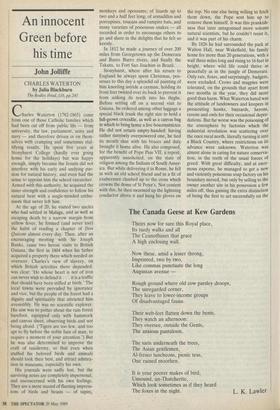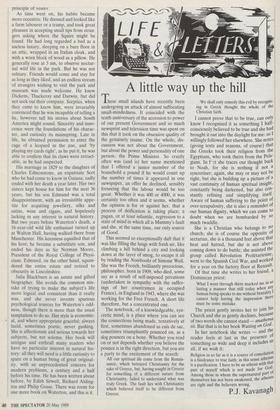An innocent Green before his time
John Jolliffe
CHARLES WATERTON by Julia Blackburn
The Bodley Head, fI6, pp.243
Charles Waterton (1782-1865) came from one of those Catholic families which had been cut off from public life — from university, the law, parliament, army and navy — and therefore driven in on them- selves with cramping and sometimes stul- tifying results. He spent five years at Stonyhurst College (hardly ever going home for the holidays) but was happy enough, simply because the Jesuits did not interfere with his early and undying pas- sion for natural history, and even had the sense to appoint him the school ratcatcher. Armed with this authority, he acquired the inner strength and confidence to follow his natural bent with a single-minded enthu- siasm that never left him.
At the age of 20, he visited two uncles who had settled in Malaga, and as well as escaping death by a narrow margin from yellow fever, he formed (and never lost) the habit of reading a chapter of Don Quixote almost every day. Then, after an encouraging meeting with Sir Joseph Banks, came two heroic visits to British Guiana, the first in 1804 when his father acquired a property there which needed an overseer. Charles's view of slavery, on which British activities there depended, was clear: 'He whose heart is not of iron can never wish to defend it . . . it is a traffic that should have been stifled at birth.' The local towns were pervaded by ignorance and vice, but the people of the forest had a dignity and spirituality that attracted him irresistibly. He was no scientific explorer. His aim was to potter about the rain forest barefoot, equipped only with hammock and canvas sheet, observing birds and not being afraid. (`Tigers are too few, and too apt to fly before the noble face of man, to require a moment of your attention.') But he was also determined to improve the craft of taxidermy, so that even when stuffed his beloved birds and animals should look their best, and attract admira- tion in museums, especially his own.
His journals were sadly lost, but the surviving notes are completely impersonal, and unconcerned with his own feelings. They are a mere record of fleeting impress- ions of birds and beasts — of tapirs, monkeys and opossums; of lizards up to two and a half feet long; of armadillos and porcupines, toucans and vampire bats, and many varieties of poisonous snakes — all recorded in order to encourage others to go and share in the delights that he felt so keenly.
In 1812 he made a journey of over 200 miles from Georgetown up the Demerara and Burro Burro rivers, and finally the Takutu, to Fort Sao Joachim in Brazil.
Stonyhurst,. where after his return to England he always spent Christmas, pos- sesses to this day a splendid oil painting of him kneeling astride a cayman, holding its front feet twisted over its back to prevent it from sinking its teeth into his thighs. Before setting off on a second visit to Guiana, he ordered among other luggage a special black trunk the right size to hold a full-grown crocodile, as well as a canvas bag in which to bring home a live boaconstrictor. He did not return empty-handed: having rather narrowly overpowered one, he tied its mouth shut with his braces and duly brought it home alive. He also composed, for the benefit of Pope Pius VII, a report, apparently unsolicited, on the state of religion among the Indians of South Amer- ica. But while delivering it in Rome, he fell in with an old school friend and in a fit of exuberance climbed up to the cross which crowns the dome of St Peter's. Not content with this, he then swarmed up the lightning conductor above it and hung his gloves on the top. No one else being willing to fetch them down, the Pope sent him up to remove them himself. It was this prankish- ness that later antagonised more solemn natural scientists, but he couldn't resist it, and it was part of his charm.
By 1826 he had surrounded the park at Walton Hall, near Wakefield, his family home for more than 20 generations, with a wall three miles long and rising to 16 feet in height, where wild life could thrive as peacefully as in the jungle of Demerara. Only rats, foxes, and surprisingly, badgers, were excluded. Crows and magpies were tolerated, on the grounds that apart from two months in the year, they did more good than harm. What Waterton hated was the attitude of landowners and keepers in persecuting hawks, buzzards, herons, ravens and owls for their occasional depre- dations. But far worse was the poisoning of the atmosphere by factories which the industrial revolution was scattering over the once rural north, literally turning it into a Black Country, where restrictions on its advance were unknown. Waterton was almost alone in caring for nature conserva- tion, in the teeth of the usual forces of greed. With great difficulty, and at enor- mous expense, he managed to get a new and violently poisonous soap factory on his boundary moved, but only by selling to the owner another site in his possession a few miles off, thus gaining the extra distinction of being the first to act successfully on the principle of NIMBY.
As time went on, his habits became more eccentric. He dressed and looked like a farm labourer or a tramp, and took great pleasure in accepting small tips from stran- gers asking where the Squire might be found. He had long regarded a bed as a useless luxury, sleeping on a bare floor in an attic, wrapped in an Italian cloak, and with a worn block of wood as a pillow. He generally rose at 3 am, to observe noctur- nal wild life in the park. But he was not solitary. Friends would come and stay for as long as they liked, and an endless stream of strangers wishing to visit the park and museum was made welcome. He knew Dickens, Thackeray and Darwin, but did not seek out their company. Sceptics, when they came to know him, were invariably convinced that he was incapable of telling a lie, however tall his stories about South America might sound. Sincerity and inno- cence were the foundations of his charac- ter, and curiosity its mainspring. Late in life, he obtained permission to enter the cage of a leopard in the zoo, and 'by playing my cards right', as he put it, he was able to confirm that its claws were retract- able, as he had suspected.
His marriage in 1829 to the daughter of Charles Edmonstooe, an expatriate Scot who he had come to know in Guiana, sadly ended with her death a year later. Her two sisters kept house for him for the next 36 years, but his son Edmund was a total disappointment, with an irresistible appe- tite for acquiring jewellery, silks and satins, wine and cigars, and hopelessly lacking in any interest in natural history. But two years before Waterton's death, a 16-year-old wild life enthusiast turned up at Walton Hall, having walked there from Manchester. His keenness equalled that of his host; he became a substitute son, and ended his days as Sir Norman Moore, President of the Royal College of Physi- cians. Edmund, on the other hand, squan- dered the entire estate and retired to obscurity in Lincolnshire.
Julia Blackburn is an astute and gifted biographer. She avoids the common mis- take of trying to make the subject's life more logical and consistent than it really was, and she never invents spurious psychological sources for Waterton's odd- ness, though there is more than the usual temptation to do so. Her style is economic- al, and where appropriate graceful; always lucid, sometimes poetic, never gushing. She is affectionate and serious towards her subjects, but not solemn. Her book will intrigue and enthrall many readers who have no particular interest in natural his- tory: all they will need is a little curiosity to spare on a human being of great original- ity, with an unprecedented concern for modern problems, a century and a half before his time. He has been written about before, by Edith Sitwell, Richard Aiding- ton and Philip Gosse. There was room for one more book on Waterton, and this is it.



































































 Previous page
Previous page